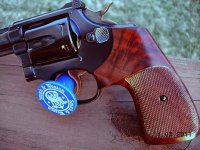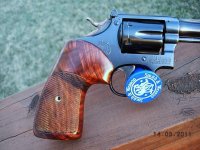i am redoing the stocks on my 19-4. They had some bad chips and the original clear was yellow and flaking. I striped them in aceton and then hit them with 0000 steel wool. i smoothed some of the chips with 100 grit but i didnt really sand the grips. i would have liked to us some 600 grit in a few spots but the steel wool looked to do OK. They wont look perfict but they should match up the "shooter" grade 19 they are going on.
So to my question. I am using tung oil as a finish. I put the 1st coat on last night with my fingertips while wearing ruber gloves. Then the 2nd coat this AM. How often should i putting coats on and when should i be using steel wool between the coats? Also i am using really light coats on my fingers. Any tips on getting it all in the checkering without getting it too heavy?
So to my question. I am using tung oil as a finish. I put the 1st coat on last night with my fingertips while wearing ruber gloves. Then the 2nd coat this AM. How often should i putting coats on and when should i be using steel wool between the coats? Also i am using really light coats on my fingers. Any tips on getting it all in the checkering without getting it too heavy?





